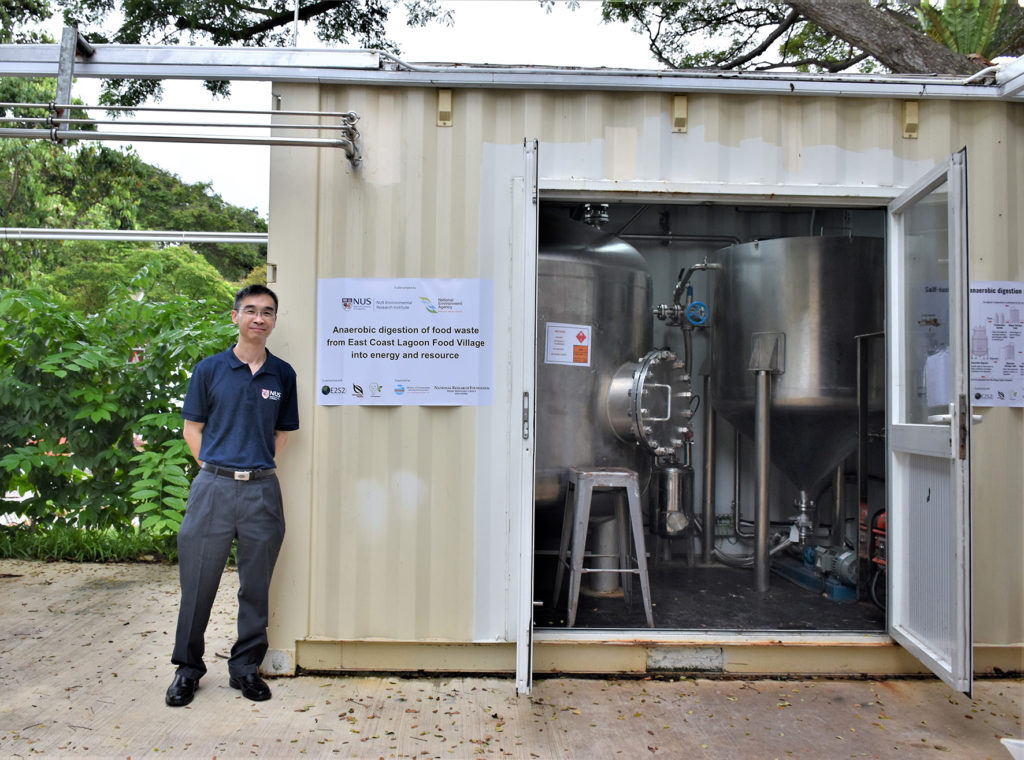Closing the Loop of Food Waste: A Hawker Centre Generates Energy and Bio-fertiliser
17 November 2021: The hawker centre East Coast Lagoon Food Village is piloting an anaerobic digestion system for food waste treatment. This aims to reduce the incineration of food waste—which would release the highest amount of CO2 emissions to the atmosphere—and instead use it to generate electricity and produce bio-fertiliser to improve the surrounding park infrastructure. The system was developed by a team of researchers from the National University of Singapore (NUS), led by Associate Professor Tong Yen Wah from the Department of Chemical and Biomolecular Engineering.
How does the system work and what does it produce?
An anaerobic digestion system takes in digestible food waste, such as fruits and vegetable trimmings, preparation scraps from the stalls and leftover table waste. Microbes then feed on the blended food waste to produce methane-rich biogas and nutrient-rich liquid digestate.
The biogas is then used to run a gas engine to generate electricity, which is able to power the system itself and two mobile phone charging stations for the public’s use. The excess electricity can also power up to 31 wall-mounted fans at East Coast Lagoon Food Village. As for the digestate, NUS is working with the National Parks Board to study its efficacy for growing ornamental plants and turn it into pathogen-free fertilisers for landscaping application around East Coast Park.
How is the system applied in the food village?
Anaerobic digestion is an established technology that has been adopted in some countries. It is mainly implemented at off-site or centralised facilities, where food waste is aggregated from neighbouring premises. However, this pilot project at the food village examines the feasibility of using anaerobic digestion as an on-site treatment solution.
East Coast Lagoon Food Village was chosen for the pilot trial because there was adjacent space available to house the anaerobic digestion system, while the bio-fertilisers could conveniently be applied at the nearby East Coast Park. There are about 60 occupied stalls in the hawker centre, altogether generating about 150 kilogrammes of digestible food waste daily. The customised anaerobic digestion system has been designed to handle this load, and serves to gather longer-term data of its application, from stakeholder behaviour to the efficacy of the digestate.
Covered bins have been provided to the stallholders and table cleaners to aid in the segregation of food waste. The food waste is then emptied into five smart bins placed around East Coast Lagoon Food Village, which are able to record and store data on the amount of segregated food waste from each of these users.
The integrated sub-systems including the waste bin loader, sorter, shredder and feeder, will enhance the system’s performance by automating the loading of food waste. In addition, it will minimise contamination of the waste fed into the system.
NUS alongside the National Environment Agency will actively engage the stakeholders involved, from hawkers to diners, to raise awareness on the importance of food waste segregation for recycling and the derived sustainability benefits. This includes posters and wall stickers to remind diners to return their trays and used crockery and encourage stallholders and cleaners to proactively segregate food waste from other waste.

Location of the anaerobic digestion system in the hawker centre.
What are its potential impacts on the built environment?
In 2020, food waste accounted for about 11 per cent of the total waste generated in Singapore, but only 19 per cent was recycled. This waste can contaminate other recyclables when they are disposed of together, making the recyclables unsuitable or difficult to recycle. It can also give rise to odour nuisance and vermin proliferation issues, if not managed properly or in a timely manner. Considering the hazard as well as the potentials, there is ample opportunity for food waste to be managed holistically.
Designers of places where a high volume of food waste is expected—such as food courts, canteens, and even residences—should consider to adopt on-site waste treatment systems to close the loop from its source. There is also the opportunity to use recycled materials in their installation. For example, the concrete base that supports the anaerobic digestion system in this food village is made from NEWSand, a by-product from the slagging gasification of general waste. If more broadly adopted, these strategies will help to reduce waste sent to the Semakau Landfill.

